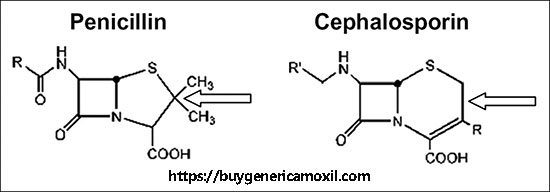We have already described the penicillin group in detail in previous articles, and now we will move on to the next generation of antibiotics: cephalosporins and macrolides.
Cephalosporins
Microbes often act, if not intelligently, then quite logically.
If they are threatened by antibiotics of the penicillin series, microbes begin to destroy penicillins (that would be so for us — something prevents us, and we are just! – and wiped off the face of the earth).
The weak link of penicillins is the so-called beta-lactam ring (you will often find this term in the description of drugs, so it is better to remember it). This is the beta-lactam ring that microbes have learned to break. And special enzymes, beta-lactamases, serve as a tool for breaking.
So, in short, the antibiotics of the cephalosporin group are all the same penicillins that work in the same way, but they are not afraid of beta-lactamases. And this means that they can deal with microbes that the same ampicillin or even amoxicillin with clavulanic acid cannot cope with.
The “arms race” between microbes and pharmacists eventually gave rise to the second, third, and then the fourth generation of cephalosporin antibiotics (when pronouncing some names of these drugs, even doctors who immediately imagine what kind of flora these antibiotics are intended for are frightened).
When doctors prescribe cephalosporins
If you are allergic to ordinary penicillins.
Of course, the chemical structure of penicillins and cephalosporins is similar, but the chance that the patient will not give an allergic reaction to cephalosporins is still very high; If penicillin antibiotics do not cope with the infection. This often happens if a patient becomes infected with some staphylococcus or streptococcus already in the hospital: the microbes there are already poisoned by anything, and therefore are especially resistant to pills from a regular pharmacy.
Microbes, unfortunately, learn quickly and evolve quickly. It is understandable: they need only 20 minutes to change generations.
And yet, doctors are always recommended to start treatment with antibiotics from the penicillin group, so as not to produce an antibiotic-resistant flora.
Antibiotics of the macrolides group
Penicillin has revolutionized the treatment of infections. But very soon it turned out that he was able to kill too. Here and there, patients began to die from anaphylactic shock caused by penicillin (remember-there are allergic reactions to penicillin?).
What could the scientists do? Only to develop new antibiotics.
Penicillin began to be massively used in 1943 (in the USA and the USSR, and almost simultaneously). And already in 1949, Alberto Aguilar in the Philippines found a new (after the green mold from which penicillin was isolated) special fungus that suppresses the growth of bacteria.
In the United States, a year later, another scientist, McGuire, isolated a new antibiotic from it — erythromycin (for some reason, Wikipedia stubbornly writes that Eli Lilly isolated it, but this is not so — McGuire just worked for him).
Erythromycin still works: it turned out that bacteria are able to adapt to it much worse than to penicillin.
What can macrolides do?
First, bacteria really adapt to macrolides much more slowly than to penicillins.
But they also adapt. That is why erythromycin has now acquired a huge family of “younger brothers” — semi-synthetic macrolides and azalides, which some pharmacists allocate to another separate group-the fourth and last group of antibiotics used in pediatrics.

Secondly, macrolides do not kill bacteria — they deprive them of the ability to multiply, as a result of which bacterial cells, without harming a person, very quickly die of their own death or become victims of the immune system.
Thirdly, macrolides can penetrate into the cells and overtake the bacteria that love to settle there so much — chlamydia and mycoplasma.
Chlamydia and mycoplasma do not have a cell wall, due to which they are invulnerable to penicillins (penicillins kill only bacteria that have a cell wall).But for macrolides, the absence of a cell wall is not an obstacle: chlamydia and mycoplasmas die when they come into contact with macrolides, although not so quickly.
When do doctors prescribe macrolides? If the patient has an allergy to penicillins or there are good reasons to believe that we are dealing with a chlamydia infection or mycoplasma pneumonia — penicillins will be powerless here.
IMPORTANT! Penicillins kill microbes at the moment of their reproduction. Macrolides deprive microbes of the ability to reproduce. So, if a doctor prescribes penicillin and erythromycin at the same time, these two antibiotics will actually … protect microbes from each other!!!